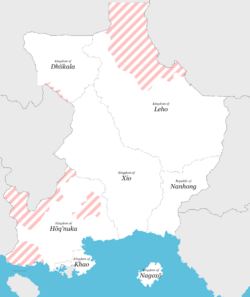Great Xio: Difference between revisions
TheRandomHat (talk | contribs) mNo edit summary |
TheRandomHat (talk | contribs) mNo edit summary |
||
| Line 99: | Line 99: | ||
|DST_note = | |DST_note = | ||
|utc_offset_DST = <!-- +N, where N is number of hours--> | |utc_offset_DST = <!-- +N, where N is number of hours--> | ||
|drives_on = | |drives_on = right | ||
|cctld = | |cctld = | ||
|iso3166code = | |iso3166code = | ||
| Line 114: | Line 114: | ||
{{wip}} | {{wip}} | ||
'''Great Xio''' (Cıoⱶαɴϵ), officially the Empire of Great Xio and informally abbreviated to Xio, is a nation on the continent of [[Aurelia]] bordering [[Sefesia]] to the southeast, [[Proncawi'chi]] to the northeast, Nuthahan to the west, and the [[Seylos|Seylosian city state of Kaseka]] to the south. | '''Great Xio''' (Cıoⱶαɴϵ), officially the Empire of Great Xio and informally abbreviated to Xio, is a nation on the continent of [[Aurelia]] bordering [[Sefesia]] to the southeast, [[Proncawi'chi]] to the northeast, Nuthahan to the west, and the [[Seylos|Seylosian city state of Kaseka]] to the south. The nation is primarily within the western [[Aurelian Wastes]] with its borders extending into the [[Auriel Gulf]] by the [[Nagaxō|Nagaxō island]]. | ||
Inhabited since the first migratory peoples of Aurelia (55kya), the lands that make up Great Xio have seen numerous waves of migratory and colonising people groups resulting in a unique phenotypical appearance of the Xioans. | |||
==Etymology== | ==Etymology== | ||
Revision as of 19:08, 12 May 2022
Empire of Great Xio Cıoⱶαɴϵ | |
|---|---|
|
Flag | |
 Map of Great Xio | |
| File:Location of Great Xio on Eurth.png Location of Great Xio on Eurth | |
| Capital | Pashae |
| Largest city | Xiseka |
| Official languages | Xi Dialect |
| Recognised national languages | Le, Nūqa, Ka. Huang |
| Recognised regional languages | Soho, Naho, Medhiatei |
| Ethnic groups (2021) | Xieika, Huang, Leika, Nuthan, Kaika, Sohoika, Nahaika, Medhiati |
| Demonym(s) | Xioan |
| Government | Communist Federal Theocracy |
• 77th Mountain Lord | Vosō Ne |
• Elected Grand Syndic | Phaakheō-voke Hisema |
• Emperor Absentia | Aidan Redmond |
| Legislature | Imperial Government & Syndic Council |
| Establishment | |
• Merchantile Xisekan Empire | 430 AD |
• First Empire of Xio | 550 AD |
• Xi Kingdom | 927 AD |
• Second Empire of Xio | 1525 |
• Empire of Great Xio | 1731 |
| Area | |
• | 784,000 km2 (303,000 sq mi) |
| Population | |
• 2021 census | 8,829,200 |
| GDP (PPP) | 2021 estimate |
• Per capita | 3,575 |
| GDP (nominal) | estimate |
• Per capita | 2100 |
| Currency | Auro (𐠓) |
| Time zone | UTC-4.30 (ALT) |
| Date format | YY/MM/DD |
| Driving side | right |
This article is incomplete because it is pending further input from participants, or it is a work-in-progress by one author. Please comment on this article's talk page to share your input, comments and questions. Note: To contribute to this article, you may need to seek help from the author(s) of this page. |
Great Xio (Cıoⱶαɴϵ), officially the Empire of Great Xio and informally abbreviated to Xio, is a nation on the continent of Aurelia bordering Sefesia to the southeast, Proncawi'chi to the northeast, Nuthahan to the west, and the Seylosian city state of Kaseka to the south. The nation is primarily within the western Aurelian Wastes with its borders extending into the Auriel Gulf by the Nagaxō island.
Inhabited since the first migratory peoples of Aurelia (55kya), the lands that make up Great Xio have seen numerous waves of migratory and colonising people groups resulting in a unique phenotypical appearance of the Xioans.
Etymology
'Xio' /ʃiɁo/ comes from old Xi-Le 'Siho' meaning 'Land of the Si People'. Xio was recontextualised to mean 'Land of the Xi People' with the rise of the maritime city of Xiseka ('City of the south').
Geography
WIP
History
WIP
• Syrbotae non-Syrbotic coastal and river city states.
• Wiped out by Kirvinan colonists and settled by !Greek Ahromans.
• Steppe and Mountain Syrbotic groups associated with original modern Syrbotae faith cult migrated south and absorbed the !Greeks.
• Syrbotic city states form, Xiseka forms coastal mercantile empire.
• Guild system from Mito late 1500s / early 1600s consolidated in 1720s to replace tribal and city power.
• Yellow Empire colonisation & Seylos colonisation. Seylos stops Yellow Empire, Xio sells emperor title.
• mid to late 1700s, annexation of Dhiikala, Khao. Mid 1800s Leho. Late 1800s Hōq'nuka. Early 1900s Nanhong. Early 2010s Nagoxō.
• Border conflicts with Sefesia in mid 1900s.
Politics
WIP
Government
WIP
Policy
WIP
Economy
WIP
Culture
WIP
Language
WIP
Religion
WIP
Holidays
WIP
